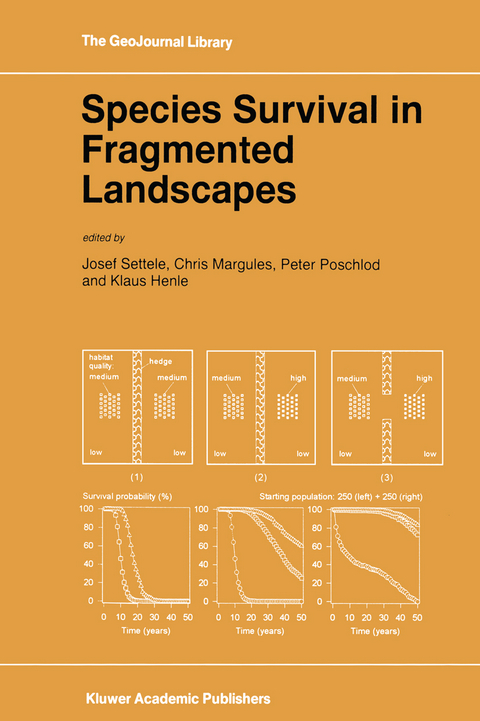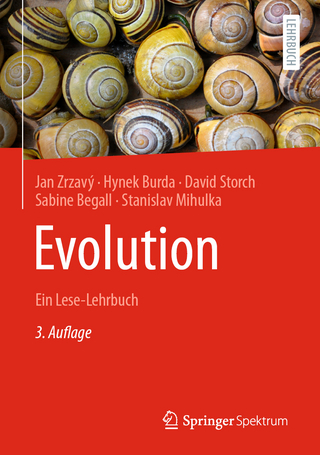
Species Survival in Fragmented Landscapes
Kluwer Academic Publishers (Verlag)
978-0-7923-4239-7 (ISBN)
I Case Studies on Species Survival in Fragmented Landscapes.- The case for a science-based strategy of conserving threatened butterfly populations in the UK and north Europe.- Decline and rehabilitation of the Apollo butterfly Parnassius apollo (LINNAEUS, 1758) in the Pieniny National Park (Polish Carpathians).- Effects of habitat fragmentation on the butterfly Maculinea alcon in the Netherlands.- Forest resource management and the conservation of arboreal marsupials in Central Victoria, South-Eastern Australia.- The conservation biology of a specialist and generalist gecko in the fragmented landscape of the Western Australian wheatbelt.- Bird population dynamics in relation to habitat quality.- Population size, genetic variation, and related parameters in small, isolated plant populations: a case study.- Habitat networks in the fragmented landscape of the Western Australian wheatbelt: Preliminary results, involvement with landcare groups, and experience in implementation.- II A Reviewof Species Survival in Fragmented Habitats: Theory and Approaches.- Species survival and metapopulations: Conservation implications from ecological theory.- Genetical aspects of fragmented plant populations.- Applications of population viability analysis in conservation biology in Australia.- Area requirements and isolation: Conservation concepts and application in Central Europe.- Dispersal of plants in fragmented landscapes - Changes of dispersal processes in the actual and historical man-made landscape.- Experimental fragmentation.- Landscape fragmentation and landscape planning, with a focus on Germany.- III The FIFB Project.- FIFB: Conceptual frame.- Studying species survival in fragmented landscapes: the approach of the FIFB.- FIFB: the hilly landscape of Halle - main study area.- The Hilly landscape of Halle - main study area of the FIFB: Natural history and the selection of target species for conservation biological research.- Vegetation Cover of porphyry Outcrops.- Vegetationstructure of the porphyry Landscape of Halle.- Relations of invertebrate species to habitat Quality in the fragmented Porphyry Landscape near Halle (Sachsen-Anhalt, Germany).- Invertebrates and area size in the porphyry Landscape of Halle.- Invertebrates and Isolation in the porphyry Landscape of Halle.- FIFB: Survival of plants in fragmented landscapes.- Why are some plant species of fragmented continental dry grasslands frequent and some rare? - The role of germination and establishment.- Survival of small isolated populations of Muscari tenuifolium TAUSCH in dry continental Grasslands - The role of reproduction.- Restoration of fallow or afforested calcareous grasslands by clear-cutting.- A coenotical approach of plant population viability analysis on successional and afforested calcareous grassland sites - Towards an ecological flora data base.- FIFB: Survival of vertebrates in fragmented landscapes.- Survival of birds in fragmented landscapes.- Survival of lizards in habitat islands in Central Europe - Introduction and summary conclusions.- Survival of the sand lizard Lacerta agilis LINNAEUS, 1758 (Sauria, Lacertidae) in relation to habitat quality and heterogeneity.- Consolidation of vineyards, mitigations, and survival of the common wall lizard (Podarcis muralis) in isolated habitat fragments.- FIFB: Survival of butterflies in fragmented landscapes.- Research on population viability of Melitaea didyma (Lepidoptera, Nymphalidae).- A population ecological study of Chazara briseis (Lepidoptera, Satyrinae).- Aspects of the population vulnerability of the large blue butterfly, Glaucopsyche (Maculinea) arion, in South-West Germany.- Towards demographic population vulnerability categories of butterflies: Requirements of and species selection for future population ecological research.- FIFB: Survival of grasshoppers and bush crickets in fragmented landscapes.- The ecological background of population vulnerability in central European grasshoppers and bush crickets: Abrief review.- A population vulnerability analysis of the stripe-winged grasshopper, Stenobothrus lineatus (Caelifera: Acrididae).- A population vulnerability analysis of the red-winged grasshopper, Oedipoda germanica (Caelifera: Acrididae).- Elements of population vulnerability of the blue-winged grasshopper, Oedipoda caerulescens (Caelifera: Acrididae).- Population vulnerability of the grey bush cricket Platycleis albopunctata (GOEZE, 1778) (Ensifera: Tettigoniidae).- FIFB: Survival of snails in fragmented landscapes.- Survival of snails in fragmented landscapes.- FIFB: Genetics, habitat models, and implementation.- Genetics of insect populations in fragmented landscapes - A comparison of species and habitats.- Mapping and assessing habitat models on the landscape level.- Implementation of FIFB results in environmental planning.- IV Summary Conclusions.- Species survival in relation to habitat quality, size, and isolation: Summary conclusions and future directions.
| Erscheint lt. Verlag | 30.9.1996 |
|---|---|
| Reihe/Serie | GeoJournal Library ; 35 |
| Zusatzinfo | XVI, 384 p. |
| Sprache | englisch |
| Maße | 160 x 240 mm |
| Themenwelt | Naturwissenschaften ► Biologie ► Evolution |
| Naturwissenschaften ► Biologie ► Ökologie / Naturschutz | |
| ISBN-10 | 0-7923-4239-9 / 0792342399 |
| ISBN-13 | 978-0-7923-4239-7 / 9780792342397 |
| Zustand | Neuware |
| Informationen gemäß Produktsicherheitsverordnung (GPSR) | |
| Haben Sie eine Frage zum Produkt? |
aus dem Bereich


